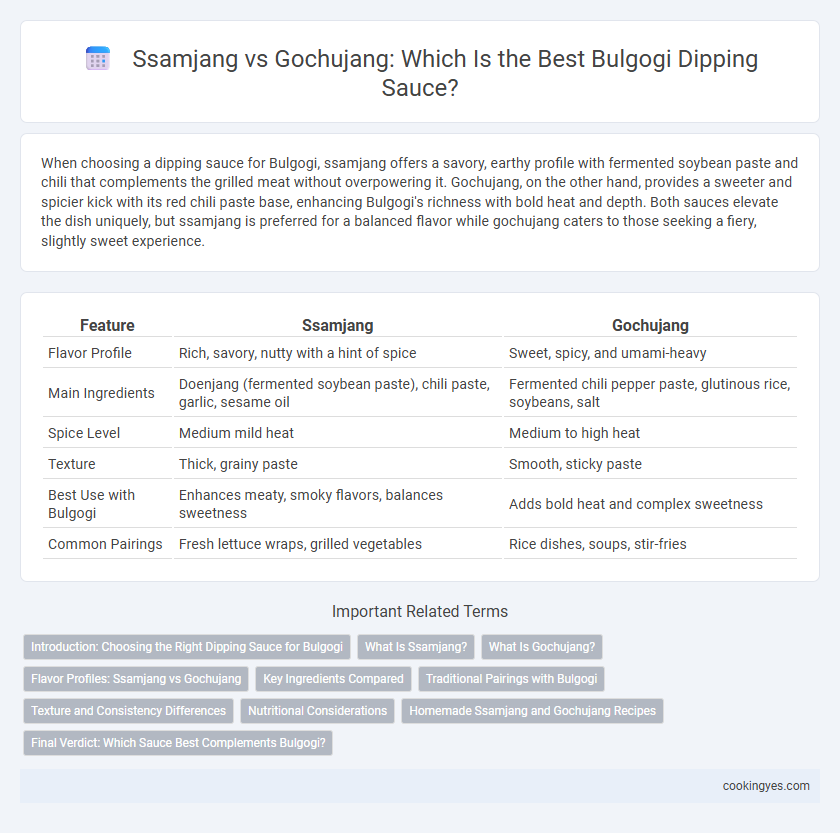When choosing a dipping sauce for Bulgogi, ssamjang offers a savory, earthy profile with fermented soybean paste and chili that complements the grilled meat without overpowering it. Gochujang, on the other hand, provides a sweeter and spicier kick with its red chili paste base, enhancing Bulgogi's richness with bold heat and depth. Both sauces elevate the dish uniquely, but ssamjang is preferred for a balanced flavor while gochujang caters to those seeking a fiery, slightly sweet experience.
Table of Comparison
| Feature | Ssamjang | Gochujang |
|---|---|---|
| Flavor Profile | Rich, savory, nutty with a hint of spice | Sweet, spicy, and umami-heavy |
| Main Ingredients | Doenjang (fermented soybean paste), chili paste, garlic, sesame oil | Fermented chili pepper paste, glutinous rice, soybeans, salt |
| Spice Level | Medium mild heat | Medium to high heat |
| Texture | Thick, grainy paste | Smooth, sticky paste |
| Best Use with Bulgogi | Enhances meaty, smoky flavors, balances sweetness | Adds bold heat and complex sweetness |
| Common Pairings | Fresh lettuce wraps, grilled vegetables | Rice dishes, soups, stir-fries |
Introduction: Choosing the Right Dipping Sauce for Bulgogi
Ssamjang and Gochujang are both essential Korean sauces but serve different flavor profiles when paired with Bulgogi. Ssamjang, a savory blend of fermented soybean paste and chili, offers a rich, umami complement that enhances the grilled beef's depth. Gochujang provides a sweeter, spicier kick, creating a bold contrast that elevates Bulgogi's tender, marinated texture.
What Is Ssamjang?
Ssamjang is a savory Korean dipping sauce made from a blend of doenjang (fermented soybean paste), gochujang (red chili paste), garlic, sesame oil, and green onions, commonly paired with grilled meats like bulgogi. It offers a rich, umami flavor with a balanced spicy and nutty profile that complements the sweet and tender marinated beef. Ssamjang's thick, textured consistency makes it ideal for wrapping bulgogi in lettuce leaves, enhancing the overall eating experience with contrasting tastes and textures.
What Is Gochujang?
Gochujang is a traditional Korean fermented red chili paste made from chili powder, glutinous rice, fermented soybeans, and salt, offering a spicy, sweet, and savory flavor profile that complements the rich, grilled taste of bulgogi. This thick, vibrant red sauce is a staple in Korean cuisine, known for its depth of umami and moderate heat, enhancing the overall eating experience when used as a dipping sauce. Its unique fermentation process not only intensifies flavor but also provides probiotic benefits, making gochujang a flavorful and nutritious choice compared to the milder, more earthy ssamjang.
Flavor Profiles: Ssamjang vs Gochujang
Ssamjang offers a rich, savory flavor with a balanced blend of fermented soybean paste, garlic, and chili, creating a bold, umami-packed complement to the grilled sweetness of bulgogi. Gochujang presents a spicier, sweeter profile with its fermented red chili pepper base, adding a complex heat and subtle tang that enhances the meat's caramelized taste. Both sauces bring distinct layers of depth, with ssamjang emphasizing earthiness and creaminess, while gochujang delivers vibrant heat and a touch of sweetness.
Key Ingredients Compared
Ssamjang for Bulgogi dipping sauce combines fermented soybean paste (doenjang), chili paste (gochujang), garlic, and sesame oil, delivering a savory and slightly nutty flavor profile. Gochujang, primarily made from fermented chili powder, glutinous rice, and fermented soybeans, offers a sweeter and spicier taste with a thick texture. The key ingredient contrast lies in ssamjang's balanced umami and richness versus gochujang's pronounced heat and sweetness.
Traditional Pairings with Bulgogi
Ssamjang, a savory and slightly spicy soybean paste mixed with garlic, sesame oil, and green onions, is traditionally paired with Bulgogi to enhance its grilled, sweet, and smoky flavors. Gochujang, a fermented red chili paste with a strong spicy and umami profile, is less commonly used but adds a bold heat that complements the marinated beef's richness. For authentic Korean dining experiences, Ssamjang is favored as a dipping sauce for Bulgogi wrapped in lettuce or perilla leaves, balancing sweetness with a subtle savory depth.
Texture and Consistency Differences
Ssamjang offers a thick, chunky texture with a hearty, rustic consistency that complements the tender, grilled Bulgogi by adding a savory, slightly gritty mouthfeel. Gochujang, in contrast, provides a smooth, paste-like consistency that is more fluid and slick, delivering a sweet-spicy kick that coats the meat evenly. The choice between the two sauces depends on whether you prefer a robust, textured dipping experience with Ssamjang or a smooth, concentrated glaze with Gochujang.
Nutritional Considerations
Ssamjang offers a balanced nutritional profile with moderate sodium and beneficial fermented soybean paste that supports gut health, making it a healthier option for Bulgogi dipping sauce. Gochujang, while rich in vitamins and antioxidants due to its chili pepper content, tends to have higher sugar content, which can increase calorie intake. Choosing ssamjang or gochujang depends on whether you prioritize lower sugar and probiotic benefits or a spicier flavor with antioxidants in your Bulgogi meal.
Homemade Ssamjang and Gochujang Recipes
Homemade ssamjang, a blend of fermented soybean paste (doenjang), chili paste (gochujang), garlic, sesame oil, and green onions, offers a savory and slightly nutty flavor that complements Bulgogi's sweet and smoky profile. Gochujang, primarily made from chili powder, glutinous rice, fermented soybeans, and salt, provides a spicy and mildly sweet taste that enhances the rich marinated beef. Crafting these sauces at home ensures control over fermentation levels and ingredient quality, creating a perfect balance to elevate the Bulgogi dipping experience.
Final Verdict: Which Sauce Best Complements Bulgogi?
Ssamjang, with its savory depth and nutty soybean paste base, enhances bulgogi's rich, marinated beef, creating a balanced flavor profile ideal for wrapping in lettuce. Gochujang offers a spicy, sweet heat that intensifies bulgogi's sweetness, making it perfect for those who prefer a more vibrant, fiery kick. For an authentic pairing that highlights bulgogi's umami while providing subtle spice, ssamjang is the best complementary dipping sauce.
Ssamjang vs Gochujang for Bulgogi dipping sauce Infographic

 cookingyes.com
cookingyes.com